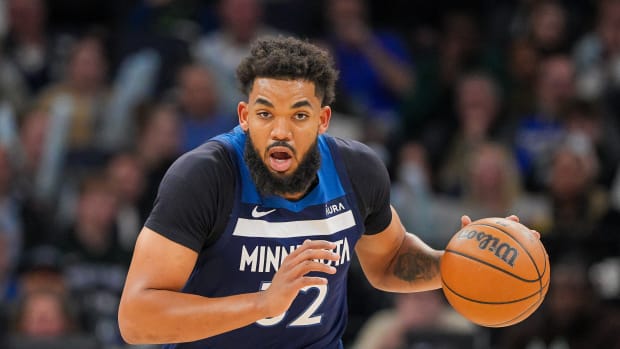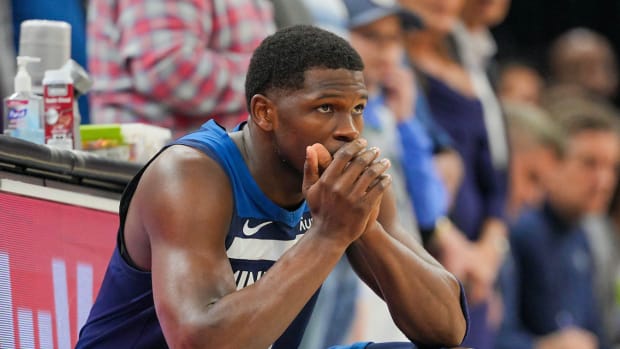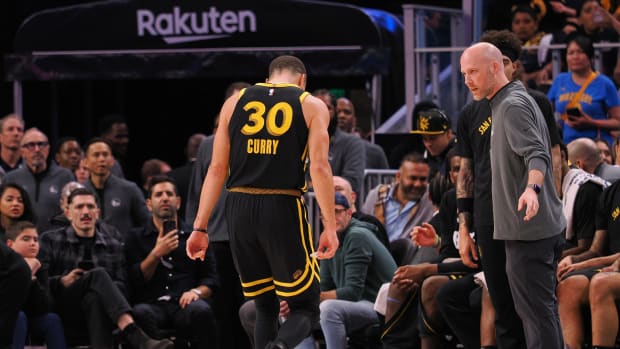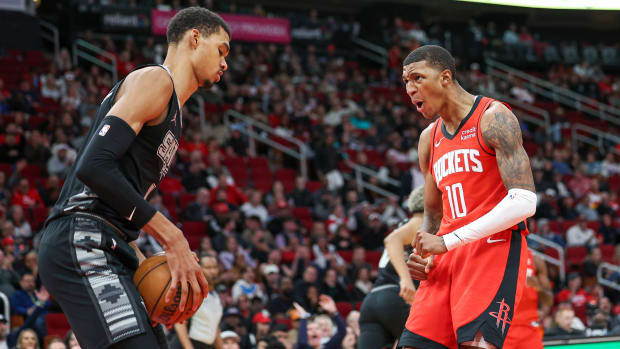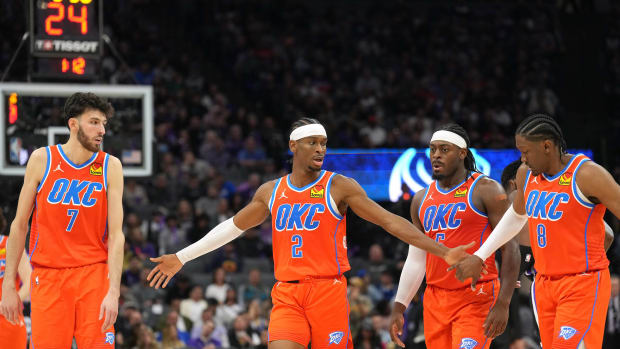2016 NBA draft Big Board 2.0: Guards shuffle in new top 30 rankings
Get all of Jeremy Woo's columns as soon as they’re published. Download the new Sports Illustrated app (iOS or Android) and personalize your experience by following your favorite teams and SI writers.
With March Madness out of the way, it’s time to revisit our Big Board. We’ve expanded to 30 prospects this time and made some changes to reflect recent developments. Super-early entry Thon Maker—still not officially eligible, mind you—makes his debut, as do many other prospects of interest.
Some key dates to keep in mind: April 24 at midnight is the early-entry deadline, which actually means less this year given the increased number of prospects. The best 60 or 70 will be invited to participate in the combine in Chicago, May 11–15, and after that, college underclassmen have until May 25 to return to school, provided they have yet to hire an agent. International players have until June 13 to withdraw.
Before we get started, here are five guys on the cusp of the first round who just missed our Big Board:
• DeAndre' Bembry (F, St. Joseph’s, Jr.) — Gifted playmaker and versatile wing who’d be a surefire first-rounder with a better jumper (26% from three).
• Ben Bentil (F, Providence, Soph.) — Undersized but talented four–man who could creep higher as the process moves forward.
• Brice Johnson (F, North Carolina, Sr.) — His strong final year at UNC didn’t fully erase past doubts surrounding his motor and inconsistencies.
• Caris LeVert (G, Michigan, Sr.) — If LeVert’s long medical history checks out OK, he’s a first-round quality talent.
• Ante Zizic (C, Croatia, age 19) — A physically mature interior force who works extremely hard on the glass.
• MORE NBA: Mock Draft 2.0: Ingram claims No. 1 | Roundtable: Thon Maker
1. Ben Simmons, LSU
RECORD: <span style="color rgb(117, 117, 117); font-family iwan-reschniev, Arial, sans-serif; font-size 30px; line-height 30px; text-transform uppercase; background-color rgb(255, 255, 255);">LAST BIG BOARD 1</span>
Equally important as Simmons’s actual workouts? His interviews. The concerns about his makeup have been duly noted, from his on– and off–court history at LSU to his relationship with Australian national teammates. It all factors in. He will have to convince teams he’ll fit in and wants to compete: keep in mind that whoever he lands with, he’ll likely have to go through a lot of losing. Remember his main selling points have always been passing, versatility, IQ and transition play more so than scoring. Those things offer a degree of certainty. He’s tricky to peg, but Simmons’s unique strengths keep him atop the board.
2. Brandon Ingram, Duke
RECORD: <span style="color rgb(117, 117, 117); font-family iwan-reschniev, Arial, sans-serif; font-size 30px; line-height 30px; text-transform uppercase; background-color rgb(255, 255, 255);">LAST BIG BOARD 2</span>
3. Dragan Bender, Maccabi Tel-Aviv
RECORD: <span style="color rgb(117, 117, 117); font-family iwan-reschniev, Arial, sans-serif; font-size 30px; line-height 30px; text-transform uppercase; background-color rgb(255, 255, 255);">LAST BIG BOARD 3</span>
One thing to keep in mind with Bender is that despite his name being a known quantity, his body of work against elite competition remains fairly small. His talent and skill level are no secret, but his extended minutes have come almost entirely in Israeli League play, not in the Euroleague. He’ll require added homework from teams (Lakers GM Mitch Kupchak recently went overseas to see him), but as one of the youngest players in the draft with size and an all–around set of tools, his upside keeps him at No. 3.
4. Jamal Murray, Kentucky
RECORD: <span style="color rgb(117, 117, 117); font-family iwan-reschniev, Arial, sans-serif; font-size 30px; line-height 30px; text-transform uppercase; background-color rgb(255, 255, 255);">LAST BIG BOARD 6</span>
5. Kris Dunn, Providence
RECORD: <span style="color rgb(117, 117, 117); font-family iwan-reschniev, Arial, sans-serif; font-size 30px; line-height 30px; text-transform uppercase; background-color rgb(255, 255, 255);">LAST BIG BOARD 4</span>
There’s no question among scouts that Dunn is the best point guard prospect available. He’s got great size and athletic ability, excels driving to the basket and has the tools to be a great defender. Though often a suspect jump-shooter, he did well from three in the tournament (7-for-10 in two games) and finished at 37% on the year. He’s not an elite ballhandler or playmaker and recently turned 22, but many think he can contribute right away, and that the more spread-out NBA game will help him. A thin positional class should prevent him from falling too far.
6. Jakob Poeltl, Utah
RECORD: <span style="color rgb(117, 117, 117); font-family iwan-reschniev, Arial, sans-serif; font-size 30px; line-height 30px; text-transform uppercase; background-color rgb(255, 255, 255);">LAST BIG BOARD 5</span>
Inarguably, Poeltl went out on a low note, getting badly outplayed by Domantas Sabonis in a loss to Gonzaga in the tourney. That said, one dud won’t wreck his stock. Scouts still love his height, nimble feet and scoring ability around the basket. He will need to get stronger and adapt to a more physical, faster-paced league. Defensively, he’s not an elite shot-blocker or especially mobile. But as a true center coming off an outstanding season, his résumé remains strong.
7. Buddy Hield, Oklahoma
RECORD: <span style="color rgb(117, 117, 117); font-family iwan-reschniev, Arial, sans-serif; font-size 30px; line-height 30px; text-transform uppercase; background-color rgb(255, 255, 255);">LAST BIG BOARD 9</span>
Hield was dominant during the Sooners’ Final Four run and helped his draft stock, but don’t get too carried away. Sure, he shot lights out—but teams already knew he could do that. Questions about his playmaking and defense still exist. He’ll be a scorer, but is he a multidimensional one? He may have played his way into the top seven, and he’ll likely be a fan favorite wherever he goes, but what translates beyond his deadly jump shot is up for debate.
8. Henry Ellenson, Marquette
RECORD: <span style="color rgb(117, 117, 117); font-family iwan-reschniev, Arial, sans-serif; font-size 30px; line-height 30px; text-transform uppercase; background-color rgb(255, 255, 255);">LAST BIG BOARD 8</span>
A legit stretch–four prospect big enough to slide over and play some center, Ellenson can run, shoot from range and rebound and has strong awareness on the floor. A useful comparison could be Trey Lyles, who’s done well for himself as a rookie big with an inside–out game. Multiple scouts have expressed concern with his lateral quickness, and in the modern game, those sorts of limitations can make it hard to keep even the most talented big men on the floor. But Ellenson should thrive in workouts, and shouldn’t slip out of the top ten.
9. Jaylen Brown, Cal
RECORD: <span style="color rgb(117, 117, 117); font-family iwan-reschniev, Arial, sans-serif; font-size 30px; line-height 30px; text-transform uppercase; background-color rgb(255, 255, 255);">LAST BIG BOARD 7</span>
March was unkind to Brown, but to be fair, the shortcomings he displayed—lack of feel, iffy jump shot—were nothing new to NBA teams. He’s an athletic specimen with a tantalizing ceiling, but has a lot to prove during the draft process. “He’s not the first freak athlete to come along,” one scout said. “If you don’t match that with understanding of how to play, you can float." There’s almost certainly going to be a steeper learning curve for Brown than what Stanley Johnson and Justise Winslow—two similarly physical wings, both with better skills and feel at the same stage—went through this season.
10. Marquese Chriss, Washington
RECORD: <span style="color rgb(117, 117, 117); font-family iwan-reschniev, Arial, sans-serif; font-size 30px; line-height 30px; text-transform uppercase; background-color rgb(255, 255, 255);">LAST BIG BOARD 10</span>
The buzz has grown in recent weeks as people have caught on to Chriss, who began the season under the radar and rode a big second half to lottery-pick status. He’s highlight–reel bouncy, active on the offensive glass and already a comfortable face–up shooter, all factors helping mitigate the fact he’s slightly undersized. He could become a pick–and–pop weapon with a chance to extend his range beyond the arc. There’s risk built in here—he didn’t do much on the defensive glass, foul trouble was an issue and he’s got plenty to learn at age 18. He’s a fascinating prospect nonetheless.
11. Timothe Luwawu, Serbia
RECORD: <span style="color rgb(117, 117, 117); font-family iwan-reschniev, Arial, sans-serif; font-size 30px; line-height 30px; text-transform uppercase; background-color rgb(255, 255, 255);">LAST BIG BOARD 13</span>
Two–way wings are always a valuable commodity, and Luwawu’s one of the best in a thin draft. Physically the appeal is clear, with a wingspan over seven feet, fluidity and bounce. Two scouts cited his passing and decision-making, he can stick with a few different positions on the perimeter, and he’s improved significantly this season playing against solid Adriatic League competition. One compared his skill profile to Jimmy Butler: “He’s not breaking you down, but he gets to his spots.” Some think he’ll be ready for rotation minutes early on.
12. Ivan Rabb, Cal
RECORD: <span style="color rgb(117, 117, 117); font-family iwan-reschniev, Arial, sans-serif; font-size 30px; line-height 30px; text-transform uppercase; background-color rgb(255, 255, 255);">LAST BIG BOARD 11</span>
Rabb was rarely featured on a perimeter–oriented Cal team, but did enough with those touches to help himself in his first season. His rebounding (“an innate ability to find the ball,” as one scout put it) and defense profile well, and an improving midrange game helps his offensive ceiling. He’s probably not NBA–ready, but not many of the higher–upside bigs in this range are. He’s shown enough to justify a lottery pick.
13. Deyonta Davis, Michigan State
RECORD: <span style="color rgb(117, 117, 117); font-family iwan-reschniev, Arial, sans-serif; font-size 30px; line-height 30px; text-transform uppercase; background-color rgb(255, 255, 255);">LAST BIG BOARD 12</span>
Boasting perhaps the top defensive profile among bigs in this class, Davis’s length, quick feet and great shot-blocking instincts continue to stand out. He and Rabb are very close here, with Davis bringing more from an athletic standpoint and the latter with a more diversified skillset. Davis should eventually find use as energy guy who runs the floor, rebounds and can corral guards on switches, and there’s some safety to be had in that. Not many freshmen have carved out serious roles in Tom Izzo’s rotation.
14. Skal Labissiere, KENTUCKY
RECORD: <span style="color rgb(117, 117, 117); font-family iwan-reschniev, Arial, sans-serif; font-size 30px; line-height 30px; text-transform uppercase; background-color rgb(255, 255, 255);">LAST BIG BOARD 14</span>
You can peg Labissiere as a bust before he ever sets foot on an NBA court, or you can take a more holistic angle. He’s a wild card to be certain. The tools that first attracted people were his mobility and defensive potential, which are still there. The other side of that is no informed party should have been completely shocked when he struggled to consistently score on the block at Kentucky. He needs reps, and to his credit, he improved over the course of a disappointing season. Someone will invest the time and resources and try to make it work.
15. Denzel Valentine, Michigan State
RECORD: <span style="color rgb(117, 117, 117); font-family iwan-reschniev, Arial, sans-serif; font-size 30px; line-height 30px; text-transform uppercase; background-color rgb(255, 255, 255);">LAST BIG BOARD 15</span>
Michigan State’s historic first–round upset loss doesn’t detract from Valentine’s body of work: a superb senior year (19.2 points, 7.5 rebounds, 7.8 assists) keeps him locked in as a first–round pick. But he won’t play the same ball-dominant role as a pro, and so the degree to which he ran the Spartans’ offense makes him a little tricky to evaluate. The physical aspect of Valentine’s game has long been in question, but there are few doubts about his makeup and savvy. As a versatile three–and–D player in the right system, he could excel.
16. Furkan Korkmaz, Anadolu Edes
RECORD: <span style="color rgb(117, 117, 117); font-family iwan-reschniev, Arial, sans-serif; font-size 30px; line-height 30px; text-transform uppercase; background-color rgb(255, 255, 255);">LAST BIG BOARD 16</span>
A tall, athletic shooter and intelligent offensive player, Korkmaz has scoring potential and has starred for Turkey at youth levels. He’s shown flashes playing with Efes’s senior team, but it’s worth noting how relatively small his sample size is against elite competition. There’s some doubt about whether he stays in the draft—he needs seasoning and time to work on his body, and would be one of the youngest players in this class. He can likely afford to wait.
17. Domantas Sabonis, Gonzaga
RECORD: <span style="color rgb(117, 117, 117); font-family iwan-reschniev, Arial, sans-serif; font-size 30px; line-height 30px; text-transform uppercase; background-color rgb(255, 255, 255);">LAST BIG BOARD 19</span>
The big man was one of the stars of March, and a breakout game against Jakob Poeltl and Utah turned some heads. Matching up with a taller opponent, Sabonis used his physicality and instincts to compensate for his lack of length, a good indicator for the next level. He projects as a mobile energy big who will hold his own on the inside and on the glass. Obviously there’s the NBA pedigree, too.
18. Tyler Ulis, Kentucky
RECORD: <span style="color rgb(117, 117, 117); font-family iwan-reschniev, Arial, sans-serif; font-size 30px; line-height 30px; text-transform uppercase; background-color rgb(255, 255, 255);">LAST BIG BOARD 20</span>
Ulis continues to climb boards, and he’s no fluke: the slithery 5’9” guard has proven himself time and again, affirming both his scoring feel and elite intangibles in March. Scouts say that were he a few inches taller, he’d be a lock for the lottery. He won’t make many mistakes, he’ll make everyone around him better, and those are two critical facets you want in a backup point guard. He’s convinced people he belongs.
19. Demetrius Jackson, Notre Dame
PREVIOUS: 6
RECORD: <span style="color rgb(117, 117, 117); font-family iwan-reschniev, Arial, sans-serif; font-size 30px; line-height 30px; text-transform uppercase; background-color rgb(255, 255, 255);">LAST BIG BOARD N/A</span>
Jackson showed very well in the NCAA tournament, displaying his athleticism and nose for the rim in leading the Irish to the Elite Eight. He’s got a good chance to be the second point guard drafted and could sneak into the back of the lottery. Not everyone is convinced. He’s not very tall, an older prospect, and lacks a surefire calling card skill-wise at the next level. “My problem is, he’s not great at controlling and running a team, and he’s not great at taking control and doing it himself either,” one NBA scout told me prior to the tournament. “But, he has all the tools to do it.”
20. Diamond Stone, Maryland
RECORD: <span style="color rgb(117, 117, 117); font-family iwan-reschniev, Arial, sans-serif; font-size 30px; line-height 30px; text-transform uppercase; background-color rgb(255, 255, 255);">LAST BIG BOARD 18</span>
Every traditional big man faces the “Can he play uptempo?” question these days, and Stone’s no exception. He’s got some things going for him: he’s huge with good touch, quality post moves and some mid-range game. Scouts are less worried about his body and defense than they were about his adjustment to the rigors of NBA regimen. Stone was inconsistent all season, especially rebounding, but in this part of the draft, there’s value to be had.
21. Wade Baldwin Iv, Vanderbilt
PREVIOUS: 6
RECORD: <span style="color rgb(117, 117, 117); font-family iwan-reschniev, Arial, sans-serif; font-size 30px; line-height 30px; text-transform uppercase; background-color rgb(255, 255, 255);">LAST BIG BOARD N/A</span>
With great quickness and long arms, Baldwin brings defensive upside as high as any guard available. He hit 40% of his threes this season, but finished out in a bit of a slump, and ultimately his offensive game hasn’t sold some who see him as a positional tweener. Multiple scouts have cited his tendency to overthink the game and get in his own way in terms of on–court attitude. There’s room for growth here, but he has work to do to pitch himself as a true point guard.
22. Thon Maker, Orangeville Prep
PREVIOUS: 7
RECORD: <span style="color rgb(117, 117, 117); font-family iwan-reschniev, Arial, sans-serif; font-size 30px; line-height 30px; text-transform uppercase; background-color rgb(255, 255, 255);">LAST BIG BOARD N/A</span>
Maker’s early entry added a little spice to this draft, assuming the NBA rules him eligible. In wake of the news, scouts’ reactions ranged from probable lottery pick to extremely skeptical. Some speculated Maker pulled out of this week’s Nike Hoop Summit so as not to risk getting exposed against the competition. He’s far from NBA ready and would benefit from D-League time. But then again, he’s a long, mobile 7–footer with a developing shot, and he’ll compete. A “Kevin Durant-Chris Paul hybrid,” he is not—but a useful high-energy player, he could be. It may take a while, but all he needs is one team to take a chance.
23. Dejounte Murray, Washington
PREVIOUS: 6
RECORD: <span style="color rgb(117, 117, 117); font-family iwan-reschniev, Arial, sans-serif; font-size 30px; line-height 30px; text-transform uppercase; background-color rgb(255, 255, 255);">LAST BIG BOARD N/A</span>
There’s a lot to like about Murray, who already moves the fun needle and could be the latest in a long line of productive Seattle-native guards: he’s known for patterning his game after his mentor, Jamal Crawford. He goes by the nickname “Baby Boy.” One optimistic scout calls him, simply, “a baller.” Murray’s an intuitive scorer and ballhandler who was error-prone as a freshman, but often made the right sort of aggressive mistakes. He has a big adjustment ahead, and his jumper needs some work. But, as another scout put it: “He does some things you can’t teach.”
24. Thomas Bryant, Indiana
PREVIOUS: 6
RECORD: <span style="color rgb(117, 117, 117); font-family iwan-reschniev, Arial, sans-serif; font-size 30px; line-height 30px; text-transform uppercase; background-color rgb(255, 255, 255);">LAST BIG BOARD N/A</span>
UPDATE: Thomas Bryant has announced he will return to Indiana for his sophomore season.
25. Taurean Prince, Baylor
PREVIOUS: 6
RECORD: <span style="color rgb(117, 117, 117); font-family iwan-reschniev, Arial, sans-serif; font-size 30px; line-height 30px; text-transform uppercase; background-color rgb(255, 255, 255);">LAST BIG BOARD N/A</span>
Prince did a little bit of everything for Baylor, with a game one scout described as “unconventional.” He’s long and strong and should be able to cut it athletically, and while he struggled some as a senior when tasked with making plays on the ball, odds are he won’t be asked to do those things in the NBA. Although he lacks an elite skill to hang his hat on, his well-rounded game makes sense as a three–and–D wing.
26. Stephen Zimmerman, UNLV
PREVIOUS: 7
RECORD: <span style="color rgb(117, 117, 117); font-family iwan-reschniev, Arial, sans-serif; font-size 30px; line-height 30px; text-transform uppercase; background-color rgb(255, 255, 255);">LAST BIG BOARD N/A</span>
Zimmerman had been turning in double doubles regularly for nearly a month before a minor knee injury sidelined him for most of February. He’s mobile, athletic (one scout mentioned a 40" vertical) and a lefty with shooting touch from mid-to-long range. One possible red flag is his right elbow, which doesn’t bend all the way after an injury he suffered when he was younger. Zimmerman’s stock remains variable, but with his distinct strengths, he could climb once the evaluation process ramps up.
27. Cheick Diallo, Kansas
PREVIOUS: 6
RECORD: <span style="color rgb(117, 117, 117); font-family iwan-reschniev, Arial, sans-serif; font-size 30px; line-height 30px; text-transform uppercase; background-color rgb(255, 255, 255);">LAST BIG BOARD N/A</span>
Diallo got buried at Kansas after an eligibility battle delayed the start of his season, never getting a real extended opportunity to play despite his lofty high school ranking. He boasts a 7’4” wingspan and 9’1” standing reach that help him compete against taller bigs. He also has a reputation among scouts for playing extremely hard. He needs a lot of seasoning, but the components are here for a useful player on both sides of the ball.
28. Grayson Allen, Duke
PREVIOUS: 6
RECORD: <span style="color rgb(117, 117, 117); font-family iwan-reschniev, Arial, sans-serif; font-size 30px; line-height 30px; text-transform uppercase; background-color rgb(255, 255, 255);">LAST BIG BOARD N/A</span>
UPDATE: Grayson Allen has announced he will return to Duke for his junior season.
29. Juan Hernangomez, Spain
PREVIOUS: 6
RECORD: <span style="color rgb(117, 117, 117); font-family iwan-reschniev, Arial, sans-serif; font-size 30px; line-height 30px; text-transform uppercase; background-color rgb(255, 255, 255);">LAST BIG BOARD N/A</span>
Hernangomez is enjoying a strong season in Spain, especially given he won’t turn 21 until September. He’ll get looks in the back end of the first round as a guy you can keep overseas for a year or two. A skilled stretch four who could eventually play some three, he’s comfortable getting his offense both spotting up and finishing inside. One scout who’s seen him firsthand cited Hernangomez’s high energy level and deceptive leaping ability (“he might dunk you, if you give him a step,”) and it helps he’s already playing legit minutes and producing in a tough league. The bloodlines are helpful, too: his brother Willy was drafted by the Knicks last season.
30. A.J. Hammons, Purdue
PREVIOUS: 7
RECORD: <span style="color rgb(117, 117, 117); font-family iwan-reschniev, Arial, sans-serif; font-size 30px; line-height 30px; text-transform uppercase; background-color rgb(255, 255, 255);">LAST BIG BOARD N/A</span>
Hammons’s name keeps coming up in conversations with league sources. He’s an intriguing risk–reward prospect despite his advanced age, and should fall into this range where teams feel more comfortable gambling on big men. There are some red flags here: on a night-in, night-out basis some worry about his effort level, and there were some off–court discipline issues at Purdue. But legit 7-footers who can run the floor will always be in demand, and on pure talent, Hammons is worth a first-round look.































